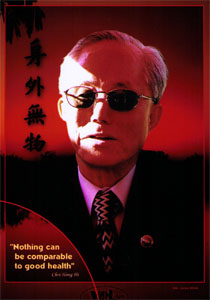Taekwondo Techniques
General Choi developed a very complete technical system that has evolved over the years. In the beginning, he used many karate-like movements that were performed rather stiffly. Research by the General and his students, as well as scientific research, led to the current technical system, which continues to evolve.
Taekwon-Do movements respect and work in harmony with the physical laws and the constitution of the human body. This is why practicing Taekwon-Do is excellent for physical growth, overall health, agility, improved co-ordination, and the development of strong mental capacities.
The techniques of Taekwon-Do can be represented as a circle. Each of the individual methods of training is added gradually, building on techniques already learned, but the student continues to practice all the different types of training.
It is necessary to apply the secrets of Taekwon-Do training, as described by General Choi in the Encyclopedia, in order to perform all the ITF Taekwon-Do techniques correctly.
Taekwon-Do is practiced in countries around the world because people appreciate the systematic learning structure offered by the ITF.
International Instructor Courses and other seminars assist ITF Taekwon-Do teachers to improve the quality of their teaching and ensure the uniformity of techniques.
A brief explanation of each of these types of training follows. Detailed illustrated explanations are found in the Encyclopedia of Taekwon-Do.
Fundamental Movements
There are more than 3,000 fundamental movements in Taekwon-Do, and General Choi was very proud of this. These movements are basic elements that can be likened to musical notes; when linked, they produce a harmonious result.
These fundamental movements use all parts of the body and are performed in harmony with the Theory of Power of Taekwon-Do. The student will practice these movements regularly with the goal of mastering each one of them, defensive and attack movements alike, so that they will be available when needed.
When practicing fundamental movements, the student must strive to use good technique, demonstrating balance, co-ordination, and good finishing (carrying through to complete the movement).
General Choi noticed that, as they progressed, students tend to neglect the practice of the fundamental movements. He encouraged all Taekwon-Do practitioners to continue practicing, to build their own storehouse of fundamental movements.
Patterns
General Choi developed twenty-four Taekwon-Do patterns. He chose the number 24 to correspond to the 24 hours in the day, a continuously repeated cycle that represents eternity. He named each pattern (except Chon-Ji) after important people in Korean history, as a reminder of the importance of honoring and cultivating respect for those who have accomplished great things. For certain patterns, the shape of the diagram and the total number of movements representing the pattern are also significant.
A Taekwon-Do pattern is a choreographed sequence of fundamental movements in an imaginary fight against one attacker or several. The execution of the movements requires the application of the Theory of Power. Correct breathing generates internal energy, which increases power.
If we imagine that the fundamental movements of Taekwon-Do are like musical notes, then the twenty-four patterns are like the songs produced by assembling those notes.
The twenty-four patterns are introduced gradually as the student progresses with his training and are beneficial for Taekwon-Do students of all ages and levels of training. The patterns must be performed precisely and smoothly; the overall effect should be one of harmonious, perfectly-controlled movement.
By practicing the patterns diligently, students can improve their memory skills, ability to concentrate, muscular development, physical coordination, and sense of balance. Each student should strive to perform the patterns to the best of his or her ability.
As explained in the section Fundamental movements, ITF techniques have evolved continuously. Important modifications occurred when General Choi introduced the concept of wave movement, which is the principle for the development of power by generating a maximum of speed and mass through relaxation, breathing, and hip movements, and his insistence that movements be executed with solid and graceful stances.
Precisely-detailed descriptions of all twenty-four patterns are found in the Encyclopedia of Taekwon-Do.
Sparring
Although Taekwon-Do is a defensive art, training by the practical application of techniques against a real adversary, or several, is very important. In fact, it is an excellent way to check what a student has learned.
Sparring is indispensable for the student who wants to progress. During sparring, he or she will test skills acquired, learn to recognize and, with practice, anticipate the opponent tactics; sparring builds self-control, self-confidence, and courage.
There are two types of sparring: step sparring and free sparring.
- Step Sparring:
- Free Sparring:
Step (or prearranged) sparring is planned by the players. They agree on the rules, such as the number of steps to be taken, the target to be attacked, the tool to be used, etc. There is no contact; the purpose is to develop control by stopping just short of the target.
There are three levels of step sparring: 3-step for beginners, 2-step or intermediate, and 1-step or advanced. The goal is to help the student understand the purpose of the movements, to master interaction with the opponent regarding stances and distances, to develop faster reflexes and instantaneous response in self-defense.
Free sparring is not pre-arranged. There is no prescribed number of steps or movements. It is essentially open combat with controlled attacks using all available means and methods. In order to prevent injury, protective equipment is worn. The teaching of free sparing is in the program starting at the yellow belt level.
According to the rules, the attacker must stop the attacking tool just before reaching certain vital spots. Only blows that stop two centimeters from a vital spot are counted. The evaluation of free sparring is based on accuracy, speed, timing, distance, and quality of technique executed. Balance, blocking and dodging skills, and attitude are also very important.
Because each of the participants is free to move and attack, free sparring encourages the development of strategies for attack and defense, while improving speed and timing. Since free sparring is practiced as a non-stop fight that may consist of one, two or three rounds, being in top physical condition is very important.
The ITF has distinct rules and a system for free sparring in tournaments. Both hand and foot techniques are allowed, and good fighters use combination and flying techniques. These fights can be really spectacular.
Breaking
Breaking is part of the program for promotion to each higher level, starting with green belt, and is included in Black Belt competitions.
The goal of breaking is to allow the student to develop self-confidence. Breaking demonstrates that the student has mastered the techniques that allow him or her to produce maximum power.
Power breaking demonstrates technical efficiency, precision, aim, and power.
Special techniques in breaking combine athletic performance with perfect execution of techniques. These techniques include flying techniques and can be spectacular. Height and length of movements are emphasized.
It is very important to practice breaking without hurting oneself. Therefore, thorough preparation is essential.
Self-defence
All Taekwon-Do techniques are to be used only for self-defence. They are not to be used for aggression, except in cases of grave immediate danger for the practitioner or someone he must protect. Any other use would be considered assault.
Because of safety concerns, the rules of competition prohibit the use of techniques using the elbow, knee, or head as well as attacks below the belt. However, these additional techniques may be needed in special circumstances, for example when defending against armed opponents, or from a sitting or prone position. Therefore, these techniques are practiced in training. Once mastered, the techniques will be available for use in genuinely dangerous situations.
Taekwon-Do offers realistic, practical, and efficient techniques for good self-defence.









